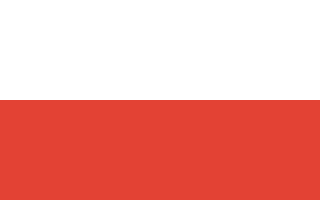
The Second Polish Republic, at the time officially known as the Republic of Poland, was a country in Central and Eastern Europe that existed between 7 October 1918 and 6 October 1939. The state was established in the final stage of World War I. The Second Republic ceased to exist in 1939, after Poland was invaded by Nazi Germany, the Soviet Union, and the Slovak Republic, marking the beginning of the European theatre of the Second World War. The Polish government-in-exile was established in Paris and later London after the fall of France in 1940.

The Gdańsk Voivodeship was a voivodeship (province) of the Polish People's Republic from 1975 to 1989, and the Third Republic of Poland from 1989 to 1998. Its capital was Gdańsk, and it was centered on the region of Pomerelia. It was established on 1 June 1975, from the parts of the voivodeships of Gdańsk, and Bydgoszcz, and existed until 31 December 1998, when it was incorporated into then-established Pomeranian Voivodeship.

The Bielsko Voivodeship was a voivodeship (province) of the Polish People's Republic from 1975 to 1989, and the Third Republic of Poland from 1989 to 1998. Its capital was Bielsko-Biała. It was established on 1 June 1975, from the parts of the voivodeships of Katowice, and Kraków, and existed until 31 December 1998, when it was partitioned between then-established Lesser Poland, and Silesian Voivodeships.
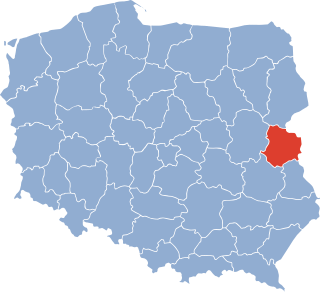
The Biała Podlaska Voivodeship was a voivodeship (province) of the Polish People's Republic from 1975 to 1989, and the Third Republic of Poland from 1989 to 1998. Its capital was Biała Podlaska. It was established on 1 June 1975, from the parts of the voivodeships of Lublin, and Warsaw Voivodeship, and existed until 31 December 1998, when it was partitioned between then-established Lublin, and Masovian Voivodeships.
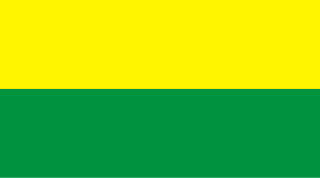
The Zielona Góra Voivodeship was a voivodeship (province) of the Polish People's Republic from 1975 to 1989, and the Third Republic of Poland from 1989 to 1998. Its capital was Zielona Góra, and it was centered on the southern Lubusz Land, in west-centre part of the county. It was established on 1 June 1975, from the part of the Zielona Góra Voivodeship, and existed until 31 December 1998, when it was incorporated into then-established Lubusz and Greater Poland Voivodeships.

The Warsaw Voivodeship, between 1975 and 1990 known as the Warsaw Capital Voivodeship, was a voivodeship (province) of the Polish People's Republic from 1975 to 1989, and the Third Republic of Poland from 1989 to 1998. Its capital was Warsaw, and it was located in the central Masovia. It was established on 1 June 1975, from the part of the Warsaw Voivodeship, and a city voivodeship of Warsaw, and existed until 31 December 1998, when it was incorporated into then-established Masovian Voivodeship.
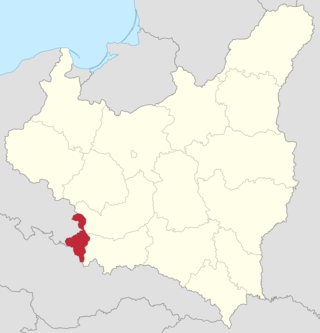
The Silesian Voivodeship was an autonomous province (voivodeship) of the Second Polish Republic. The bulk of its territory had formerly belonged to the German/Prussian Province of Silesia and became part of the newly reborn Poland as a result of the 1921 Upper Silesia plebiscite, the Geneva Conventions, three Upper Silesian Uprisings, and the eventual partition of Upper Silesia between Poland, Germany and Czechoslovakia. The remainder had been the easternmost portion of Austrian Silesia which was partitioned between Poland and Czechoslovakia following the collapse of Austria-Hungary, the Polish–Czechoslovak War and the Spa Conference of 1920. The capital of the voivodeship was Katowice.

Hinduism in Poland is a minority religion. Hinduism has spread to Poland through ISKCON since 1976. First groups of Polish devotees were established in Warsaw and Wrocław. The first Polish Hindu temple was established in 1980 in Czarnów, Lower Silesian Voivodeship. Main ISKCON temple is New Ramana Reti Temple in Mysiadło.
Raczki Elbląskie is a village in the administrative district of Gmina Elbląg, within Elbląg County, Warmian-Masurian Voivodeship, located in northern Poland. It is situated approximately 4 kilometres (2 mi) northwest of Elbląg and 83 km (52 mi) northwest of the regional capital, Olsztyn.
Żółwiniec is a village in the administrative district of Gmina Markusy, within Elbląg County, Warmian-Masurian Voivodeship, in northern Poland. It lies approximately 6 kilometres (4 mi) north-east of Markusy, 4 km (2 mi) east of Elbląg, and 77 km (48 mi) north-west of the regional capital Olsztyn.
East Upper Silesia is the easternmost extremity of Silesia, the eastern part of the Upper Silesian region around the city of Katowice. The term is used primarily to denote those areas that became part of the Second Polish Republic on 20 June 1922, as a consequence of the post-World War I Treaty of Versailles. Prior to World War II, the Second Polish Republic administered the area as Autonomous Silesian Voivodeship. East Upper Silesia was also known as Polish (Upper) Silesia, and the German (Upper) Silesia was known as West Upper Silesia.

Jan Piekałkiewicz was a Polish economist and statistician, politician and the Polish Underground State's Government Delegate.
Protestantism in Poland is the third largest faith in Poland, after the Roman Catholic Church (32,440,722) and the Polish Orthodox Church (503,996). As of 2018 there were 103 registered Protestant denominations in Poland, and in 2023 there were 130,000 Protestants in the country.

The demographics of Poland constitute all demographic features of the population of Poland including population density, ethnicity, education level, the health of the populace, economic status, religious affiliations, and other aspects of the population.

The Lutheran Diocese of Warsaw is one of the six dioceses of the Evangelical Church of the Augsburg Confession in Poland, covering most of central and eastern Poland. The Lutheran population in the area in 2016 was 3968, which amounts to about 7% of the total number of adherents of the church in Poland. There were 18 ordained ministers in the diocese in 2016.
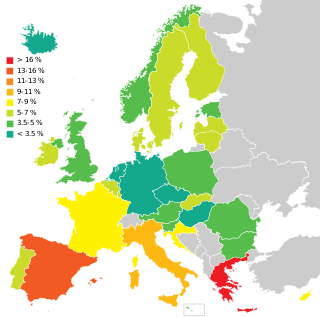
Unemployment in Poland is one of the lowest in European Union. Poland's unemployment rate remains impressively low, reflecting a robust labor market and steady economic growth. This trend is driven by a combination of strong industrial output, foreign investment, and a dynamic services sector. The country's focus on education and skill development has also helped align the workforce with market demands, reducing joblessness. Additionally, Poland's integration into the European Union has facilitated labor mobility and economic opportunities, further supporting low unemployment rates. As a result, Poland continues to enjoy one of the lowest unemployment rates in Europe, contributing to its economic stability and social well-being.

The Polish-Catholic Church in the Republic of Poland, also known as the Church of Poland or Polish-Catholic Church, is a Polish Old Catholic church in Poland.

The Gdańsk Voivodeship was a voivodeship (province) with capital in Gdańsk, that was located in the region of Pomerelia. It existed from 1945 to 1975. Until 28 June 1945, it remained under the administration of the Provisional Government of the Republic of Poland, which then was replaced by the Provisional Government of National Unity. On, 19 February 1947, the provisional government was replaced by the Polish People's Republic. It was established on 7 April 1945, from the parts of the territories of the Pomeranian Voivodeship, and the Masurian District, Poland. The voivodeship ceased to exist on 31 May 1975, when it was partitioned by then-established voivodeships of Elbląg, Gdańsk, and Słupsk.

The Koszalin Voivodeship was a voivodeship (province) of the Polish People's Republic, with capital in Koszalin, that existed from 1950 to 1975. It was established on 6 July 1950, from the eastern half of the Szczecin Voivodeship, and existed until 31 May 1975, when it was partitioned between then-established voivodeships of Koszalin, Słupsk, and Piła.

The Koszalin Voivodeship was a voivodeship (province) of the Polish People's Republic from 1975 to 1989, and the Third Republic of Poland from 1989 to 1998. Its capital was Koszalin, and it was centered on the eastern Farther Pomerania. It was established on 1 June 1975, from the part of the Koszalin Voivodeship, and existed until 31 December 1998, when it was incorporated into then-established West Pomeranian Voivodeship.



















